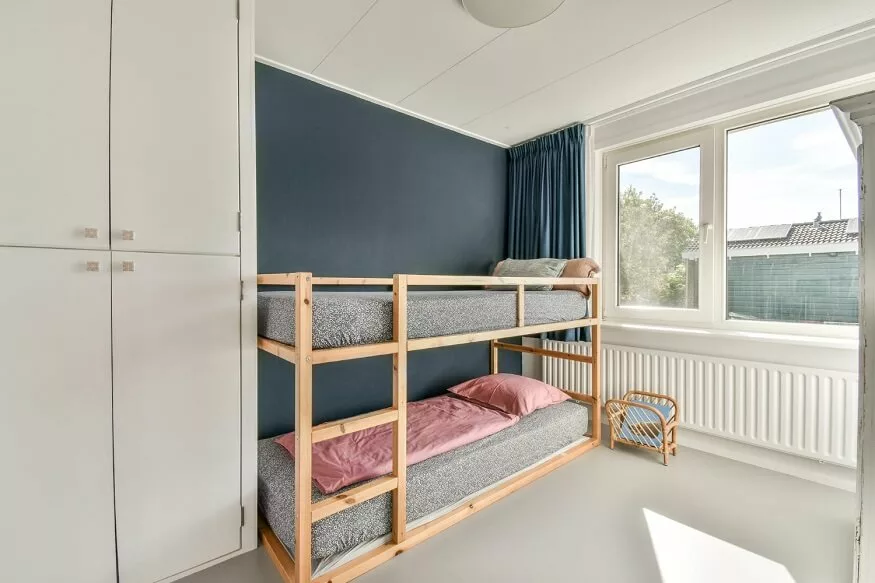Explore the world of bunk beds for children, delving into their numerous benefits for space efficiency and bonding, while navigating potential risks and gaining essential safety tips for a secure environment.
What Are Bunk Beds or Loft Beds?
Bunk beds, also known as loft beds, have been a popular choice for children’s bedrooms for decades. They are designed to maximise space by stacking one-bed frame on top of another, creating a two-tiered sleeping arrangement. The structure often includes a ladder or stairs for easy access to the upper bunk. Bunk beds come in various designs, catering to different preferences and room layouts.
Benefits of Bunk Beds for Kids
Space Utilisation
One of the primary advantages of bunk beds is their space-saving design. In rooms where space is limited, bunk beds provide an excellent solution, allowing two or more children to share a room comfortably without sacrificing floor space.
Social Interaction
Bunk beds can foster a sense of companionship and camaraderie among siblings or friends sharing a room. The proximity encourages bonding and shared experiences, contributing to positive social development.
Versatility
Many bunk beds are designed with additional features, such as built-in storage drawers or desks, enhancing the functionality of the furniture. This versatility is particularly beneficial in smaller bedrooms where maximising utility is crucial.
Cost-Effective
Investing in bunk beds can be a cost-effective solution for families with multiple children. Rather than purchasing separate beds and using more floor space, a bunk bed offers an efficient and economical alternative.
Also Read: Best Ways to Sleep Train Your Baby – Methods, Tips and When to Try It
How One Can Choose the Right Bunk Bed for Kids
Choosing the right bunk bed involves considering various factors to ensure the safety and comfort of the children. Here are some key considerations:
- Age and Size of Children:
- Material and Construction:
- Bunk Bed Configuration:
- Additional Features:
Bunk beds are generally suitable for children aged six and above. Younger children may struggle with climbing to the upper bunk. Consider the size and weight capacity of the bunk bed to ensure it can accommodate the intended users comfortably.
Opt for bunk beds made from sturdy and durable materials like solid wood or metal. Check the construction for safety features such as guardrails on the upper bunk and secure ladders or stairs.
Bunk beds come in different configurations, including twin-over-twin, twin-over-full, and loft beds. Choose a configuration that best fits the room layout and the needs of the children using the bed.
Consider bunk beds with added features like storage space, trundle beds, or built-in desks if extra functionality is desired. These features can enhance the overall utility of the furniture.
Also Read: What is Bedwetting: Causes and solutions for children
Bunk Bed Risks and Dangers for Kids
While bunk beds offer numerous benefits, it’s essential to be aware of potential risks and dangers associated with their use:
- Fall Hazards:
- Entrapment:
- Inadequate Construction:
- Improper Mattress Fit:
- Age Appropriateness:
The most significant risk associated with bunk beds is the potential for falls, especially from the top bunk. Lack of guardrails, unstable ladders, or children engaging in rough play can contribute to accidents.
Gaps between the guardrails, headboards, or footboards can pose an entrapment risk for small children. It’s crucial to choose bunk beds with proper spacing to prevent accidental entanglement.
Poorly constructed bunk beds may pose a safety hazard. Weak joints, loose screws, or unstable frames can lead to the collapse of the bed, resulting in injuries.
Ensuring that the mattresses fit snugly into the bed frames is crucial. Gaps between the mattress and the bed frame can increase the risk of entrapment or falls. Choose mattresses that meet the size specifications of the bunk bed.
While bunk beds are generally suitable for older children, it’s essential to consider the maturity and coordination of the child. Younger children may not have the physical capability to navigate the ladder or stairs safely.
Also Read: Top 10 Benefits of Reading Bedtime Stories For Kids
Safety Tips for Bunk Beds
To mitigate the risks associated with bunk beds, implementing the following safety tips is imperative:
Strict Age Limit:
Only allow older children, typically aged six and above, to use the upper bunk. Younger children may lack the coordination and judgement required for safe access and use.
Guardrails:
Ensure that the bunk bed has sturdy guardrails on all sides of the upper bunk to prevent accidental falls during sleep or play. Guardrails should be securely attached and have no gaps that could lead to entrapment.
Sturdy Ladder or Stairs:
Check the stability of the ladder or stairs. They should be firmly attached to the bed frame and provide a secure means of access to the upper bunk. Teach children to use the ladder or stairs safely, emphasising one person at a time.
Regular Inspections:
Periodically inspect the bunk bed for any signs of wear and tear. Tighten screws, bolts, or any loose parts promptly. Replace any damaged components to maintain the structural integrity of the bed.
No Jumping or Rough Play:
Discourage children from engaging in rough play on or around the bunk bed. Jumping on the beds can lead to accidents and compromise the stability of the structure.
Also Read: How To Put Newborn To Sleep With Appropriate Sleepwear
Bed Bunk Construction Guidelines
When assembling or purchasing a bunk bed for kids, adhere to these construction guidelines to ensure safety:
- Solid Materials:
- Sturdy Joints:
- Smooth Surfaces:
- Proper Mattress Support:
Choose bunk beds made from solid, durable materials such as hardwood or metal. Avoid beds constructed from flimsy materials that may compromise the stability of the structure.
Check that all joints and connections are sturdy and well-constructed. Reinforce any weak joints and ensure that the bed frame can withstand the weight of the occupants.
Ensure that all surfaces are smooth and free from sharp edges or protruding hardware. This reduces the risk of injuries caused by accidental bumps or collisions.
Confirm that the bunk bed provides proper support for the mattresses. Mattress platforms should be secure and prevent sagging, ensuring a comfortable and safe sleep surface.
Also Read: Discovering Your Child’s Circadian Rhythms
Where to Safely Place a Child’s Bunk Bed
The location of a child’s bunk bed within the bedroom is as crucial as its construction and safety features. Follow these guidelines for optimal placement:
- Avoid Near Ceiling Fans:
- Adequate Ceiling Height:
- Away from Windows:
- Secure to the Wall:
- Accessible Emergency Exits:
Ensure that the bunk bed is not positioned directly beneath a ceiling fan. This reduces the risk of accidents and injuries when the fan is in operation.
Check the ceiling height to ensure there is enough space between the upper bunk and the ceiling. This prevents injuries and allows for easy access to the upper bunk.
Position the bunk bed away from windows to prevent the risk of falls or accidents related to window access. Children should not be able to reach windows from the bunk bed.
To prevent accidental tipping, consider securing the bunk bed to the wall. This adds an extra layer of stability, especially if the bed is placed in a location where it may be bumped or jostled.
In case of an emergency, ensure that children can easily access emergency exits from the bunk bed. Avoid placing the bed in a way that obstructs doors or windows designated for escape routes.
Also Read: Tips to creating a room for siblings to share
Bunk beds for kids can be a practical and space-efficient solution for shared bedrooms. However, it’s crucial to balance the benefits with an awareness of potential risks and hazards. EuroSchool says that regular maintenance and supervision further contribute to ensuring the long-term safety and functionality of bunk beds in a child’s bedroom.











